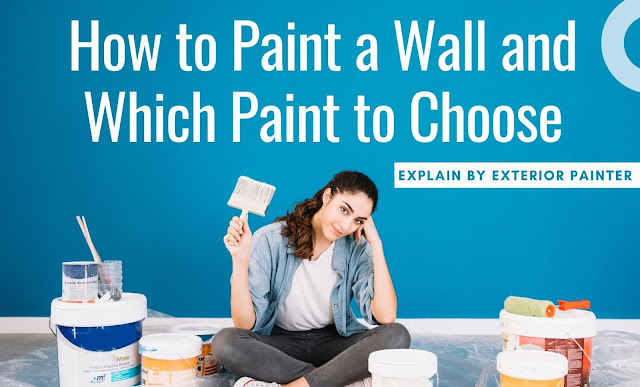Exterior Painter Explain: How to Paint a Wall and Which Paint to Choose
Painting the external walls is tiring, so it is
necessary to do it well so as not to have to repeat the operation.
If you were to rely on a figure specialized in
whitewashing, you could have too high a cost. So, what could be the solution to
achieve optimal results with little cost and little effort? Continue reading
the information given below by the
exterior painter Toronto.
In This Content
·
How to paint exteriors wall
·
Common Condition of the Walls
·
Which painting to choose?
How to paint exteriors wall
First of all, you need to choose the right day,
not too sunny, but also sheltered from cold or rain. Optimal for these
operations are the evening hours.
It is necessary to choose the best materials, not
to save on equipment, but on labor. It is necessary to have a brush to prepare
the wall, a scraper to remove the plaster, and the wall detached from the
walls. It is very important to spotless the base that will be painted and then
dry the substrate. Cracks must be removed or repaired.
The second operation is the application of an
absorbent base, with the help of a brush. The corners and edges are the first
things to paint, it is possible to use other shades of color always following
the main one.
We then move on to the first coat of paint, to be
diluted with about 10% of water, to which it is possible to add a fungicide, an
anti-mold, etc. For the final coat of paint, it is recommended by the exterior painter to
use a roller, transversally and longitudinally to uniform the color.
Common Condition of the Walls
Everything seems to be ready to start painting,
if not for a final check, that of the surface on which you are going to
operate; to proceed with the painting and obtain good results, the walls must
necessarily meet certain conditions.
Absence of cracks
It is essential to intervene promptly, as even a
small crack can expand and cause damage to the building (such as infiltration
of water and humidity) and weaken the load-bearing structures (with the risk of
collapse).
In case of cracks, repair them, apply a skin coat
reinforced with glue and mesh and finish with a thick coating, or finish off
and paint after applying fixative.
This is a solution that you can successfully
adopt in minor cases; in the presence of deep and serious injuries, it is
always better to request professional intervention, in order not to compromise
the safety of the entire building.
Absence of peeling
In case of peeling, it is advisable to intervene
by removing the damaged plaster, moisten the bare parts with a wet sponge and
apply a mixture based on cement, lime, sand, and water, which must be kept wet
for a couple of hours and, once adhered and dried, sanded to align with the old
plaster still intact.
Only then can you start painting the wall.
Before working on the plaster make sure you have
good dexterity and the necessary equipment, otherwise, the damage could be
greater than the benefits.
Getting professional help can save you time and
effort.
Absence of humidity
The exterior painter recommends that before you start painting, you also need to make sure
the walls are free from mold, algae, and moss.
To protect the health of the inhabitants and
prevent the signs of humidity from returning even after painting, we recommend
that you rely on a professional diagnosis of the thermal insulation of your
home.
Which paint to choose?
After having understood how to paint the
exteriors adequately and organize the work, you need to equip yourself with the
right materials, including the optimal painting.
On the market, it is possible to find different types of products, and it is essential to choose the one that best meets the needs of the wall to be painted to have the desired result. In this way, you will avoid having to repeat the operation after only a few months. Check out the detailed guide here: Best House Paint Colors
·
QUARTZ: This type
of paint is suitable for renewing the paint that is still in good condition,
and is mainly white but can be added with various colors. It has a rough finish
and needs to be applied with a special roller.
·
ACRYLIC: also in this case, for the use of this product, the facade must be in
good condition. It is applied with a wool roller or a flat brush, it is long-lasting
and has no odor. The base color is white, but it can be colored differently by
adding other products.
·
POLITE: This type
of paint is suitable for painting the exteriors of holiday homes, very close to
the sea, or located in very sunny places. The finish is smooth, and the color
is white, which can be added with outdoor colors. Requires a solvent-based
fixative. The advantages are breathability and water repellency.
·
LIME: This is a
product suitable for painting walls damaged by small cracks or bubbles, which
require a homogeneous coat. This paint is anti-crack and also breathable and
water repellent. It is applied with a brush or roller.
·
ACRYLIC: It is recommended to use this product to prevent problems due to
humidity. The finish is sheer and creates a natural effect on the surface. It
is necessary to fix the product with an acrylic fixative after use.




Comments
Post a Comment